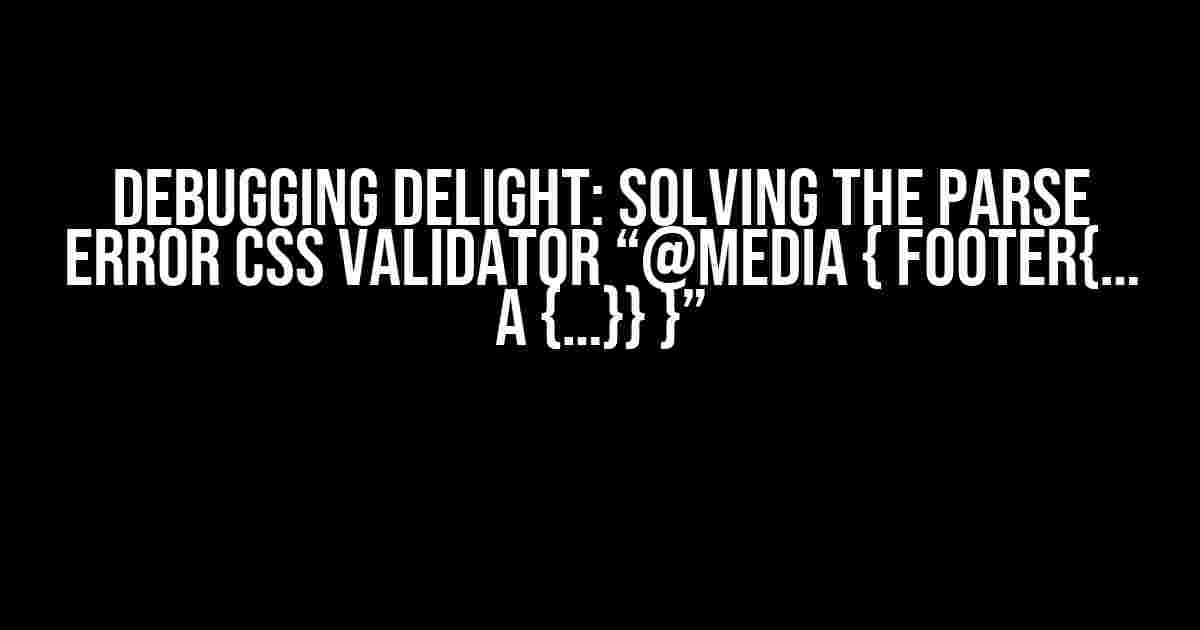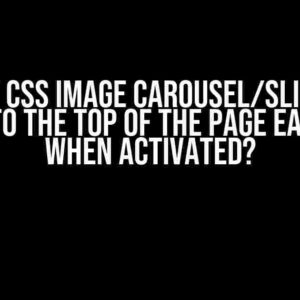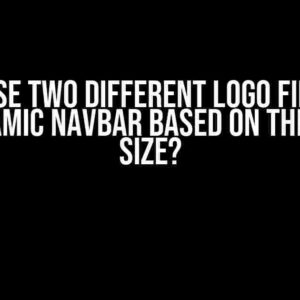Ah, the joys of CSS debugging! You’ve written what you thought was a perfectly valid CSS code, only to be greeted by the infamous parse error message from the CSS validator. Specifically, the error in question is “@media { footer{… a {…}} }”. Fear not, dear reader, for today we’ll embark on a journey to uncover the root cause of this issue and provide you with a step-by-step guide to resolving it.
Understanding the Error Message
Before we dive into the solution, let’s break down the error message itself. The CSS validator is complaining about the syntax within the @media rule. Specifically, it’s unhappy about the nested selector syntax used for the footer and anchor (a) elements.
@media {
footer {
... /* some declarations */
a {
... /* some declarations */
}
}
}The error message is indicating that there’s a problem with the way these selectors are defined. But what’s wrong, exactly?
The Culprit: The Faulty Syntax
The issue lies in the lack of a property and value combination within the footer selector. In CSS, a selector must be followed by a property and value combination, separated by a colon (:). Without this, the CSS parser gets confused and throws an error.
footer {
/* No property and value combination! Oh no! */
a {
/* Some declarations */
}
}In this example, the footer selector is missing a property and value combination. This is what’s causing the CSS validator to throw a parse error.
Solution: Adding a Property and Value Combination
The fix is surprisingly simple. You just need to add a property and value combination to the footer selector. This can be anything, really – a styling declaration, a layout tweak, or even just a placeholder.
footer {
/* Add a property and value combination to save the day! */
background-color: #f2f2f2;
a {
/* Some declarations */
}
}By adding the background-color property and setting it to #f2f2f2, we’ve satisfied the CSS parser’s hunger for a valid property and value combination. The error should now be resolved!
Best Practices for Avoiding Parse Errors
While we’ve solved the immediate issue, it’s essential to discuss some best practices to avoid parse errors in the future:
- Use a CSS linter or validator regularly: Tools like CSSLint or the W3C CSS Validator can catch syntax errors and provide valuable feedback on your code.
- Keep your selectors simple and modular: Avoid complex, nested selectors like the one that caused our original error. Instead, break them down into smaller, more manageable pieces.
- Use a consistent coding style: Establish a coding convention for your team or personal projects, and stick to it. This will help reduce errors and make your code more readable.
- Test and iterate: Don’t be afraid to experiment and try different approaches. Test your code frequently and make adjustments as needed.
Common Parse Errors and Their Solutions
In addition to our original error, there are several other common parse errors that may arise in your CSS journey. Here are a few examples, along with their solutions:
| Error | Solution |
|---|---|
| Unclosed bracket or parenthesis | Check your code for any missing closing brackets or parentheses. |
| Invalid selector syntax | Verify that your selectors follow the correct syntax and are properly closed. |
| Mismatched property and value combinations | Ensure that each property is followed by a colon (:) and a valid value. |
| Unknown or unsupported property | Check the CSS specification or MDN Web Docs to ensure the property is valid and supported. |
Conclusion
There you have it – a comprehensive guide to debugging the parse error “@media { footer{… a {…}} }” in CSS. By understanding the root cause of the issue and applying the solutions outlined above, you’ll be well-equipped to tackle even the most stubborn parse errors.
Remember, CSS debugging is an art that requires patience, persistence, and practice. Don’t be discouraged by errors – instead, view them as opportunities to learn and improve your coding skills.
Happy coding, and may your CSS be error-free!
- Always keep your CSS code organized and tidy.
- Use a CSS linter or validator to catch syntax errors early.
- Test your code regularly to ensure it’s working as intended.
Frequently Asked Questions
Q: What’s the difference between a CSS validator and a linter?
A: A CSS validator checks your code against the official CSS specification, ensuring it meets the standard. A linter, on the other hand, checks for best practices, coding conventions, and potential errors. Think of it as a validator for syntax and a linter for code quality.
Q: Can I use a CSS framework to avoid parse errors?
A: While CSS frameworks can provide a solid foundation for your code, they’re not a foolproof solution. You can still introduce parse errors if you don’t follow the framework’s guidelines or make mistakes in your custom CSS. Use a framework as a starting point, but always validate and test your code.
Q: How can I stay up-to-date with the latest CSS developments and best practices?
A: Follow reputable sources like the W3C, MDN Web Docs, and industry leaders on social media. Participate in online forums and communities, and attend conferences or workshops to stay current and network with fellow developers.
Frequently Asked Questions
Get answers to your burning questions about the CSS validator parse error!
What’s causing the parse error in my CSS code: “@media { footer{… a {…}} }”?
The culprit behind the parse error is the missing colon (:) after the footer selector! In CSS, when you declare a selector, it needs to be followed by a colon (:) to separate it from the properties. So, the corrected code should be: “@media { footer: { … } a { … } }”.
Why is the CSS validator being so picky about the syntax?
The CSS validator is just doing its job! It’s there to ensure that your code follows the official CSS syntax rules, which are defined by the World Wide Web Consortium (W3C). By being “picky” about the syntax, the validator helps you catch errors and inconsistencies that might cause issues in different browsers or devices.
Will this parse error affect my website’s functionality?
Fortunately, a single parse error in CSS usually doesn’t cause catastrophic issues. However, if left unchecked, it can lead to layout problems, inconsistencies, or even break your website’s design. Fixing the error ensures that your website looks and functions as intended across different browsers and devices.
How can I avoid similar parse errors in the future?
To avoid parse errors, always validate your CSS code using tools like the W3C CSS Validator or plugins like CSSLint. These tools will help you catch syntax errors, typos, and inconsistencies. Additionally, follow best practices like using a consistent coding style, commenting your code, and testing in different browsers.
What’s the best way to troubleshoot CSS parse errors?
When troubleshooting CSS parse errors, start by checking the CSS validator’s error message, which usually points to the exact location of the error. Then, review your code line by line, and use the process of elimination to identify the problematic selector, property, or value. You can also try commenting out sections of code or using the browser’s developer tools to isolate the issue.



